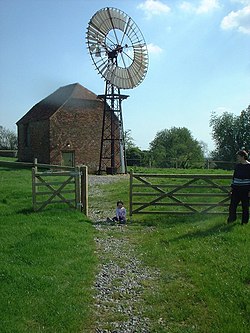| Crux Easton Wind Engine | |
|---|---|
 The restored wind engine | |
 | |
| Origin | |
| Mill name | Crux Easton Wind Engine |
| Grid reference | SU 4267 5634 |
| Coordinates | 51°18′17″N1°23′21″W / 51.3046°N 1.3892°W |
| Operator(s) | Crux Easton Wind Engine Restoration Trust |
| Year built | 1891 |
| Information | |
| Purpose | Pumping mill, sawmill and corn mill |
| Type | Simplex geared wind engine |
| No. of sails | One sail |
| Type of sails | Annular sail |
| Winding | Fantail |
| Fantail blades | Six blades |
| No. of pairs of millstones | One pair |
| Type of saw | Circular saw |
| Other information | Built by John Wallis Titt |
Crux Easton wind engine is a Grade II listed [1] Titt wind engine, used as a windpump, at Crux Easton, Hampshire, England, which has been restored to working order.